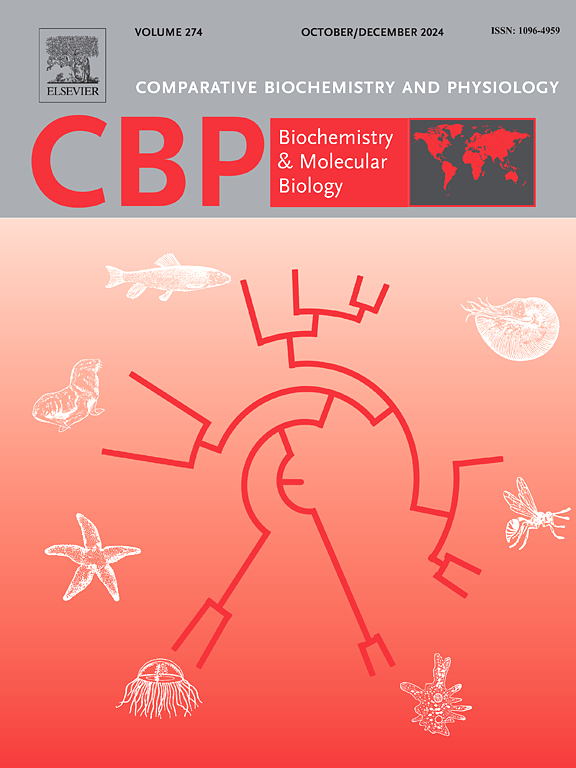viperin在大黄鱼干扰素信号通路中的调控机制:启动子区域的表征。
IF 1.8
3区 生物学
Q4 BIOCHEMISTRY & MOLECULAR BIOLOGY
Comparative Biochemistry and Physiology B-Biochemistry & Molecular Biology
Pub Date : 2025-06-05
DOI:10.1016/j.cbpb.2025.111115
引用次数: 0
摘要
Viperin(病毒抑制蛋白,内质网相关蛋白,ifn诱导)是一种广谱抗病毒蛋白,广泛参与脊椎动物先天免疫调节。本研究克隆了大黄鱼(Larimichthys crocea) viperin基因(命名为LcViperin)的5'侧翼启动子区域(2010 bp),并通过生物信息学和双荧光素酶报告基因分析了其启动子特征。结果表明,LcViperin启动子区域包含两个TATA盒子和几个关键的转录因子结合位点,包括干扰素刺激反应元件(ISREs)、gata结合因子1 (GATA1)、活化B细胞核因子kappa-轻链增强子(NF-κB)、干扰素调节因子7 (IRF7)和信号转导和转录激活因子1 (STAT1)。HEK 293 T细胞启动子区域截断实验进一步证实,核心启动子区域位于-331和 - 121 bp之间。LcViperin过表达显著激活IRF3、IRF7和IFN1启动子,呈剂量依赖性。结构域缺失实验表明,n端和SAM (s -腺苷- l-蛋氨酸)结构域在启动子激活中起关键作用。此外,LcViperin和IRAK1(白细胞介素-1受体相关激酶1,称为LcIRAK1)共转染显著增强了IRF3、IRF7和IFN1启动子活性。本研究揭示了大黄鱼viperin启动子的调控特性及其在干扰素信号通路中的作用,为了解其免疫调控机制,提高大黄鱼抗病能力提供理论依据。为了解蛇毒素的调控作用及其在水产养殖疾病防治中的应用提供了科学依据。本文章由计算机程序翻译,如有差异,请以英文原文为准。

Regulatory mechanism of viperin in the interferon signaling pathway of large yellow croaker: Characterization of the promoter region
Viperin (Virus inhibitory protein, endoplasmic reticulum-associated, IFN-inducible) is a broad-spectrum antiviral protein widely involved in vertebrate innate immune regulation. This study cloned the 5′ flanking promoter region (2010 bp) of the viperin gene (named as LcViperin) in large yellow croaker (Larimichthys crocea) and analyzed its promoter characteristics through bioinformatics and dual-luciferase reporter assays. Results indicated that the LcViperin promoter region contains two TATA boxes and several critical transcription factor binding sites, including interferon-stimulated response elements (ISREs), GATA-binding factor 1 (GATA1), nuclear factor kappa-light-chain-enhancer of activated B cells (NF-κB), interferon regulatory factor 7 (IRF7), and signal transduction and activator of transcription 1 (STAT1). Promoter region truncation experiments in HEK 293 T cells further confirmed that the core promoter region is located between −331 and − 121 bp. LcViperin overexpression significantly activated IRF3, IRF7, and IFN1 promoters in a dose-dependent manner. Domain deletion experiments demonstrated that the N-terminal and SAM (S-adenosyl-L-methionine) domains play key roles in promoter activation. Additionally, co-transfection with LcViperin and IRAK1 (interleukin-1 receptor-associated kinase 1, named as LcIRAK1) significantly enhanced IRF3, IRF7, and IFN1 promoter activity. This study reveals the regulatory characteristics of the large yellow croaker viperin promoter and its role in the interferon signaling pathway, providing a theoretical basis for understanding its immune regulatory mechanism and improving disease resistance in large yellow croaker. It also offers a scientific basis for understanding viperin regulation and its application in disease prevention in aquaculture.
求助全文
通过发布文献求助,成功后即可免费获取论文全文。
去求助
来源期刊
CiteScore
4.60
自引率
4.50%
发文量
77
审稿时长
22 days
期刊介绍:
Comparative Biochemistry & Physiology (CBP) publishes papers in comparative, environmental and evolutionary physiology.
Part B: Biochemical and Molecular Biology (CBPB), focuses on biochemical physiology, primarily bioenergetics/energy metabolism, cell biology, cellular stress responses, enzymology, intermediary metabolism, macromolecular structure and function, gene regulation, evolutionary genetics. Most studies focus on biochemical or molecular analyses that have clear ramifications for physiological processes.

 求助内容:
求助内容: 应助结果提醒方式:
应助结果提醒方式:


